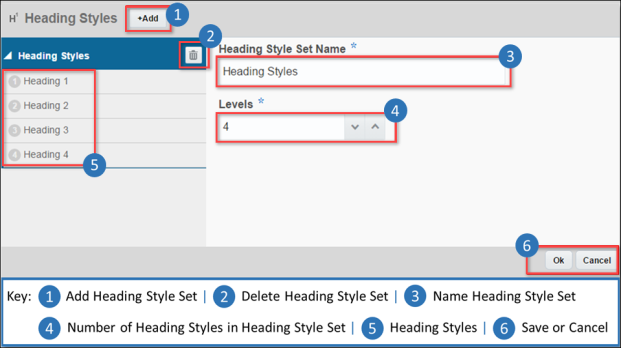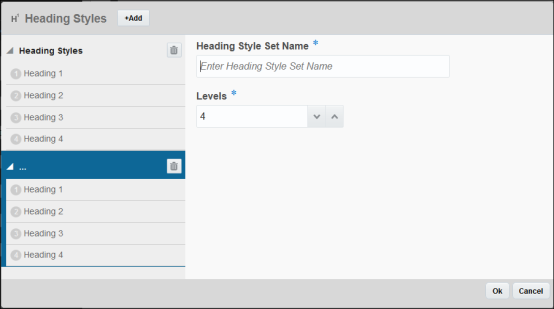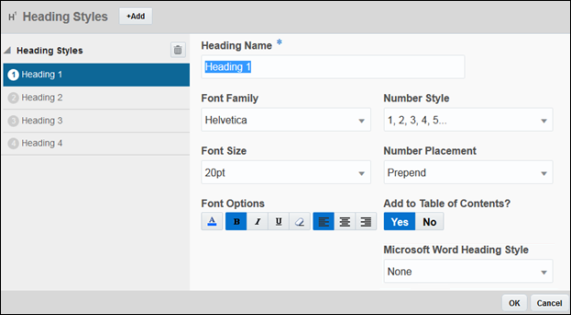Document Designer Heading Styles and Style Sets
Overview
Heading Styles and Heading Style Sets are used to format Heading Elements and determine which Heading Elements will appear in the Table of Contents.
Heading styles can also be replicated from Microsoft Word. Instead of having to recreate the style elements of your Microsoft Word styles in all the Headings in Document Designer, you can create documents in Document Designer that match your existing Microsoft Word document styles.
For more information on using Microsoft Word-style headings, see the section Microsoft Word Heading Styles below.
Administration
 Accessing the Heading Styles Element Editor Window
Accessing the Heading Styles Element Editor Window
To access the Heading Styles Element editor window, where Heading Styles and Heading Style Sets can be created, deleted, and modified:
- Open the Document Properties pane (by clicking a blank area in the Admin Action Bar or the Template Flow so that no Layout or Element is selected).
- Click the Heading Styles button (
 ) in the Dynamic Content Bar.
) in the Dynamic Content Bar.
 Heading Styles Editor Window
Heading Styles Editor Window

| 1 |
Click +Add to add a new Heading Style Set.
|
| 2 |
Click the Delete icon to delete the Heading Style Set.
|
| 3 |
Enter a name for the Heading Style Set in the Heading Style Set Name field.
|
| 4 |
Use the Levels field to add or remove Heading Styles from the selected Heading Style Set. The value of the Levels field determines how many Heading Styles exist for the selected Heading Style Set.
|
| 5 |
Click a Heading Style to edit its name, font, font size, font color, formatting, alignment number style, number placement, and whether or not the Heading Elements associated with the Heading Style will be included in the Table of Contents.
|
| 6 |
Click OK to save changes to the Heading Style Sets and Heading Styles. Click Cancel to close the window and lose all changes.
|
 Heading Style Sets
Heading Style Sets
Heading Styles are organized within Heading Style Sets. At least one Heading Style Set must be present within the template. A Table of Contents Layout will only reference Heading Elements whose Heading Styles are within the Heading Style Set that is linked to the Table of Contents (set within the Table of Contents properties pane). This allows for Table of Contents Layouts in different parts of the template to only reference the Heading Elements within that part of the template, and not all Heading Elements in the template.
Creating a Heading Style Set
- Click a blank space in the Template Flow so that no Layout or Element is selected.
- Click the Heading Styles button (
 ) in the Dynamic Content Bar.
) in the Dynamic Content Bar.
-
Click the +Add button.
A new Heading Style Set appears in the left panel.

- Enter a name for the Heading Style Set Name.
-
Set a number for Levels.
This determines how many Heading Styles are in the Heading Style Set. By default, Heading Style Sets contain four Heading Styles. Heading Style Sets can contain a maximum of ten Heading Styles.
- Click OK to save all Heading Styles changes, and therefore the new Heading Style Set.
 Heading Styles
Heading Styles
Each Heading Style can be formatted individually and contains options relating to numbering and placement in the Table of Contents.
Opening a Heading Style for modification
- Click a blank space in the Template Flow so that no Layout or Element is selected.
- Click the Heading Styles button (
 ) in the Dynamic Content Bar.
) in the Dynamic Content Bar.
- Click Expand icon (
 ) for the Heading Style Set that the Heading Style is within.
) for the Heading Style Set that the Heading Style is within.
-
Click the Heading Style’s name in the left panel to open the Heading Styles Element dialog box.

|
Heading Name
|
The name of the Heading Style.
|
|
Font Family
|
The font that all Heading Elements that reference this Heading Style will have in the output.
|
|
Font Size
|
The font size that all Heading Elements that reference this Heading Style will have in the output.
|
|
Font Options
|
The additional formatting options that all Heading Elements that reference this Heading Style will have in the output.
|
|
Number Style
|
The numbering style that all Heading Elements that reference this Heading Style will have in the output if Number Placement is not set to None.
|
|
Number Placement
|
Where numbers will be placed in regards to all Heading Elements that reference this Heading Style. Prepend will place numbering before all Heading Elements. Append will place numbering after all Heading Styles. If None is selected, Heading Styles will not be numbered.
|
|
Add to Table of Contents
|
Determines whether or not Heading Elements that reference this Heading Style will appear in the Table of Contents.
|
Microsoft Word
Heading Style |
Determines whether or not the selected Microsoft Word Heading Style is used when the printed output is DOCX, or if you are opening RTF output in Microsoft Word.
For more information, see the section Microsoft Word Heading Styles.
|
 Microsoft Word Heading Styles
Microsoft Word Heading Styles
These Heading Styles will display in the selected Microsoft Word Heading Style when the printed output is DOCX, or if you are opening RTF output in Microsoft Word. The Heading Styles will reflect the Document Designer settings if the document is output as a PDF.

 Using Microsoft Word Heading Styles
Using Microsoft Word Heading Styles
The Heading Style will display in the corresponding Microsoft Word Heading Style when the printed output is RTF or DOCX. The Heading Style will be the values specified in the Document Designer if the document is printed as a PDF.
The Oracle CPQ default Heading Styles mimic the Heading Styles in the default installation of Microsoft Word, version 2013. Your installation of Microsoft Word may have different styles.
When a Heading Style has an equivalent Microsoft Word style, Heading Style properties can still be modified in the Document Designer. These edits will only appear when a document is printed as a PDF.
 Microsoft Word Heading Styles and the Table of Contents
Microsoft Word Heading Styles and the Table of Contents
The Table of Contents is equivalent to a Microsoft Word Table of Contents when printing in DOCX format. The Title Element will follow the built-in Word style for TOC Heading.
Just as with Document Designer Headings, after generating the Word output, if the Section Headings change, that change will be reflected in the Table of Contents. If content is moved or modified, page numbers in the Table of Contents will update as well.
As with all document changes, the Table of Contents in the DOCX file must be updated before it shows any changes.
Notes
Related Topics
 See Also
See Also
![]() Accessing the Heading Styles Element Editor Window
Accessing the Heading Styles Element Editor Window
 ) in the Dynamic Content Bar.
) in the Dynamic Content Bar.![]() Using Microsoft Word Heading Styles
Using Microsoft Word Heading Styles
![]() Microsoft Word Heading Styles and the Table of Contents
Microsoft Word Heading Styles and the Table of Contents









